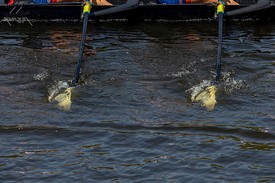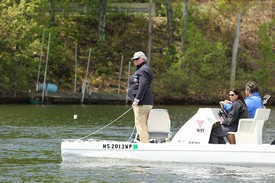Charlotte Hollings, Calm Waters Rowing

As we get back on the water, one of the most common mistakes I see is burying the blade too deep. There are many reasons for this but the result is the same - a less effective drive. And if the blade is going deep while you're rowing steady state, it's almost certain to go even deeper when you up the pressure.
If you're not sure if this is something you do, just take a look at the shaft of the oar at any point during your row. If the water line is halfway or further up the shaft, you're digging. From my experience, it's impossible to keep all of the shaft dry, but if you can keep the waterline below a third of the way up the shaft, you're doing pretty well.

Ideally, we want only the blade to be buried on the drive. With the boat set and the blades squared, gently take any pressure off the oars and see where the blades float. A Concept2 blade will float just slightly out of the water, as will a Croker blade, while Drehers tend to be completely under the water. Assuming your pitch is correct, once the blades get buried at the catch, it should stay just below the surface of the water until right before the release.
I find there are four main causes for digging. First, check your grip. If your hand is so far around the oar handle that your wrist is cocked up, you're more likely to pull up. You're also more likely to actively pull, rather than hang, with your arms during the beginning of the drive. Adjust your grip so only your fingers touch the handle and the wrist is level when the blade is squared.
Second, don't try to force the blade in the water at the catch, ie don't "chop" at the water. It is simply too easy to go deep so instead of making an effort to lift the handle, try to unweight your hands. Gravity will drop the blade in and the engineering of the oar is such that it will find the right depth on its own, given that you don't force it to go somewhere else. Where all of this gets particularly difficult is as we start to row with more power, then we need the catch to be quick without it being too hard - a fine balancing act.

Third, don't start the drive before you catch. Often the catch becomes part of the drive, hence too much pressure put into the catch. We coach the catch as being separate from the drive. Catch then drive. If you catch and drive, invariably the body goes up and with it the arms and the oar, making the blade go deep. Try to keep the body still, catching with the forearms, leaving the body in position to work the drive.

Fourth, too much tension in the shoulders. It is guaranteed that the shoulders are higher than the hands so too much emphasis on the shoulders will cause an upward force that will drive the blade deep. Instead, put the emphasis on your core right at the oarhandle height, to get a solid, horizontal drive.
Here are a couple of drills I have found useful:
-Try rowing with almost no pressure. This will allow you to see the path the oars will take if you don't exert any up or down pressure. Just float the hands on the oar/s, keeping them level so as to keep the boat set.
-Another drill is to try rowing with the blades half buried. You'll have to literally push down slightly on the oar handle to keep the blade from burying completely. Most people manage to not over-bury the blades while doing this drill but rarely on the first attempt do they actually keep the blades half buried, despite feeling that they're not putting any upward pressure on the oar. It will allow you to see just how little pressure it takes to find the correct depth.

If you enjoy and rely on row2k, we need your help to be able to keep doing all this. Though row2k sometimes looks like a big, outside-funded operation, it mainly runs on enthusiasm and grit. Help us keep it coming, thank you! Learn more.
Comments | Log in to comment |
- Bont Rowing
- Calm Waters Rowing
- Concept 2
- Craftsbury Sculling
- The Crew Classic
- CrewLAB
- Croker
- Dad Vail Regatta
- Durham Boat Co.
- Empacher
- Faster Masters
- Filippi
- Fluidesign
- h2row.net
- HUDSON
- Live2Row Studios
- Nielsen-Kellerman
- Oak Ridge RA
- Peinert Boat Works
- Pocock Racing Shells
- Race1 USA
- Rockland Rowing Masters Regatta
- RowKraft
- Rubini Jewelers
- Vespoli USA
- WinTech Racing
- Bont Rowing
- Calm Waters Rowing
- Concept 2
- Craftsbury Sculling
- The Crew Classic
- CrewLAB
- Croker
- Dad Vail Regatta
- Durham Boat Co.
- Empacher
- Faster Masters
- Filippi
- Fluidesign
- h2row.net
- HUDSON
- Live2Row Studios
- Nielsen-Kellerman
- Oak Ridge RA
- Peinert Boat Works
- Pocock Racing Shells
- Race1 USA
- Rockland Rowing Masters Regatta
- RowKraft
- Rubini Jewelers
- Vespoli USA
- WinTech Racing

















01/27/2020 10:12:01 AM
04/04/2018 6:29:56 PM
05/21/2017 10:28:57 AM
05/10/2017 3:52:24 PM
06/14/2017 4:17:32 PM
05/12/2017 3:24:42 PM
05/11/2017 12:12:24 PM
05/12/2017 4:05:47 PM
05/10/2017 7:05:08 PM